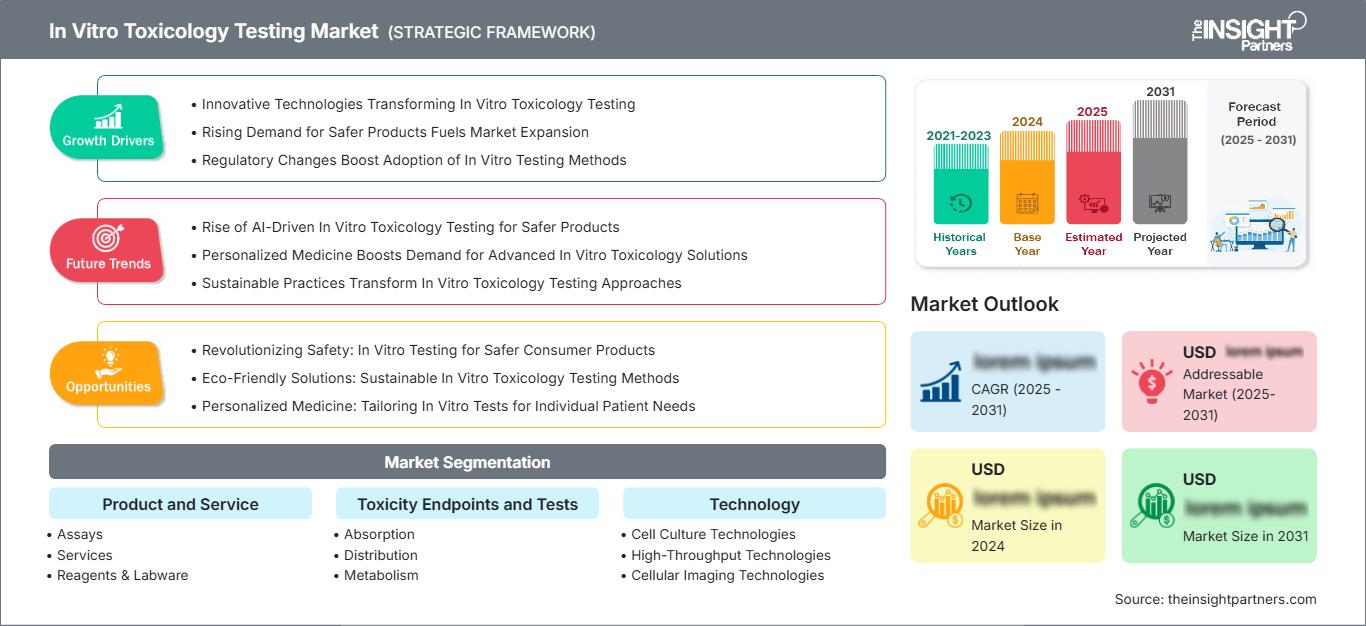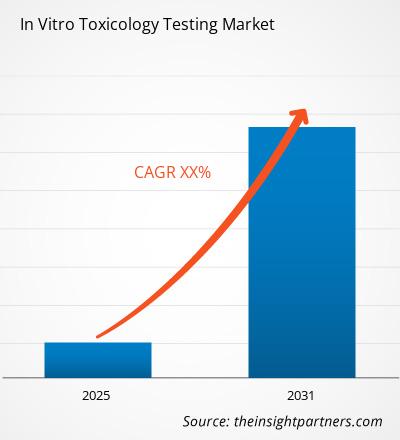Si prevede che il mercato dei test tossicologici in vitro raggiungerà i 40,21 miliardi di dollari entro il 2031. Si prevede che il mercato registrerà un CAGR dell'11,0% nel periodo 2025-2031.
Il rapporto è suddiviso in base a prodotti e servizi (analisi, servizi, reagenti e materiale di laboratorio) e analizza ulteriormente il mercato in base a endpoint e test di tossicità (assorbimento, distribuzione, metabolismo, escrezione, irritazione cutanea, corrosione, sensibilizzazione, test di genotossicità, test di citotossicità, tossicità oculare, tossicità organica, test di fototossicità, tossicità dermica, cancerogenicità, neurotossicità, altri endpoint e test di tossicità). Esamina inoltre il mercato per tecnologia (tecnologie di coltura cellulare, tecnologie ad alta produttività, tecnologie di imaging cellulare, tossicogenomica) e settore industriale (industria farmaceutica e biofarmaceutica, industria cosmetica e dei prodotti per la casa, industria alimentare, industria chimica). Per ciascuno di questi segmenti chiave viene fornita una ripartizione completa a livello globale, regionale e nazionale. Il rapporto include dimensioni e previsioni di mercato per tutti i segmenti, presentando i valori in USD. Fornisce inoltre statistiche chiave sullo stato attuale del mercato dei principali attori, insieme ad approfondimenti sulle tendenze di mercato prevalenti e sulle opportunità emergenti.
Scopo del rapporto
Il rapporto "In Vitro Toxicology Testing Market" di The Insight Partners mira a descrivere il panorama attuale e la crescita futura, i principali fattori trainanti, le sfide e le opportunità. Ciò fornirà spunti a vari stakeholder aziendali, come:
- Fornitori/produttori di tecnologia: per comprendere le dinamiche di mercato in evoluzione e conoscere le potenziali opportunità di crescita, consentendo loro di prendere decisioni strategiche informate.
- Investitori: per condurre un'analisi completa delle tendenze in merito al tasso di crescita del mercato, alle proiezioni finanziarie del mercato e alle opportunità esistenti lungo la catena del valore.
- Organismi di regolamentazione: per regolamentare le politiche e le attività di controllo nel mercato con l'obiettivo di ridurre al minimo gli abusi, preservare la fiducia degli investitori e sostenere l'integrità e la stabilità del mercato.
Segmentazione del mercato dei test tossicologici in vitro, prodotti e servizi
- Saggi
- Servizi
- Reagenti e materiale di laboratorio
Endpoint e test di tossicità
- Assorbimento
- Distribuzione
- Metabolismo
- Escrezione
- Irritazione cutanea
- Corrosione
- Sensibilizzazione
- Test di genotossicità
- Test di citotossicità
- Tossicità oculare
- Tossicità organica
- Test di fototossicità
- Tossicità cutanea
- Carcinogenicità
- Neurotossicità
- Altri endpoint e test di tossicità
Tecnologia
- Tecnologie di coltura cellulare
- Tecnologie ad alta produttività
- Tecnologie di imaging cellulare
- Tossicogenomica
Industria
- Industria farmaceutica e biofarmaceutica
- Industria dei cosmetici e dei prodotti per la casa
- Industria alimentare
- Industria chimica
Potrai personalizzare gratuitamente qualsiasi rapporto, comprese parti di questo rapporto, o analisi a livello di paese, pacchetto dati Excel, oltre a usufruire di grandi offerte e sconti per start-up e università
Mercato dei test tossicologici in vitro: Approfondimenti strategici

-
Ottieni le principali tendenze chiave del mercato di questo rapporto.Questo campione GRATUITO includerà l'analisi dei dati, che vanno dalle tendenze di mercato alle stime e alle previsioni.
Fattori di crescita del mercato dei test tossicologici in vitro
- Tecnologie innovative che trasformano i test tossicologici in vitro
- La crescente domanda di prodotti più sicuri alimenta l'espansione del mercato
- Le modifiche normative stimolano l'adozione di metodi di test in vitro
Tendenze future del mercato dei test tossicologici in vitro
- Ascesa dei test tossicologici in vitro basati sull'intelligenza artificiale per prodotti più sicuri
- La medicina personalizzata aumenta la domanda di soluzioni avanzate di tossicologia in vitro
- Le pratiche sostenibili trasformano gli approcci ai test tossicologici in vitro
Opportunità di mercato per i test tossicologici in vitro
- Rivoluzionare la sicurezza: test in vitro per Prodotti di consumo più sicuri
- Soluzioni ecocompatibili: metodi sostenibili per i test tossicologici in vitro
- Medicina personalizzata: test in vitro personalizzati in base alle esigenze individuali dei pazienti
Mercato dei test tossicologici in vitro
Le tendenze regionali e i fattori che influenzano il mercato dei test tossicologici in vitro durante il periodo di previsione sono stati ampiamente spiegati dagli analisti di The Insight Partners. Questa sezione illustra anche i segmenti di mercato e la geografia della gestione delle malattie del ritmo cardiaco in Nord America, Europa, Asia-Pacifico, Medio Oriente e Africa, America meridionale e centrale.
Ambito del rapporto di mercato sui test tossicologici in vitro
| Attributo del rapporto | Dettagli |
|---|---|
| Dimensioni del mercato in 2024 | US$ XX Billion |
| Dimensioni del mercato per 2031 | US$ 40.21 Billion |
| CAGR globale (2025 - 2031) | 11.0% |
| Dati storici | 2021-2023 |
| Periodo di previsione | 2025-2031 |
| Segmenti coperti |
By Prodotti e servizi
|
| Regioni e paesi coperti |
Nord America
|
| Leader di mercato e profili aziendali chiave |
|
Densità degli operatori del mercato dei test tossicologici in vitro: comprendere il suo impatto sulle dinamiche aziendali
Il mercato dei test tossicologici in vitro è in rapida crescita, trainato dalla crescente domanda degli utenti finali, dovuta a fattori quali l'evoluzione delle preferenze dei consumatori, i progressi tecnologici e una maggiore consapevolezza dei benefici del prodotto. Con l'aumento della domanda, le aziende stanno ampliando la propria offerta, innovando per soddisfare le esigenze dei consumatori e sfruttando le tendenze emergenti, alimentando ulteriormente la crescita del mercato.

- Ottieni il Mercato dei test tossicologici in vitro Panoramica dei principali attori chiave
Punti di forza
- Copertura completa: il rapporto copre in modo completo l'analisi di prodotti, servizi, tipologie e utenti finali del mercato dei test tossicologici in vitro, fornendo un panorama olistico.
- Analisi degli esperti: il rapporto è compilato sulla base della conoscenza approfondita di esperti e analisti del settore.
- Informazioni aggiornate: il rapporto garantisce rilevanza aziendale grazie alla sua copertura di informazioni recenti e tendenze dei dati.
- Opzioni di personalizzazione: questo rapporto può essere personalizzato per soddisfare le esigenze specifiche del cliente e adattarsi in modo appropriato alle strategie aziendali.
Il rapporto di ricerca sul mercato dei test tossicologici in vitro può, quindi, aiutare a guidare il percorso di decodificazione e comprensione dello scenario del settore e delle prospettive di crescita. Sebbene possano esserci alcune preoccupazioni valide, i vantaggi complessivi di questo rapporto tendono a superare gli svantaggi.
- Analisi storica (2 anni), anno base, previsione (7 anni) con CAGR
- Analisi PEST e SWOT
- Valore/volume delle dimensioni del mercato - Globale, Regionale, Nazionale
- Industria e panorama competitivo
- Set di dati Excel
Report recenti
Rapporti correlati
Testimonianze
Motivo dell'acquisto
- Processo decisionale informato
- Comprensione delle dinamiche di mercato
- Analisi competitiva
- Analisi dei clienti
- Previsioni di mercato
- Mitigazione del rischio
- Pianificazione strategica
- Giustificazione degli investimenti
- Identificazione dei mercati emergenti
- Miglioramento delle strategie di marketing
- Aumento dell'efficienza operativa
- Allineamento alle tendenze normative






















 Ottieni un campione gratuito per - Mercato dei test tossicologici in vitro
Ottieni un campione gratuito per - Mercato dei test tossicologici in vitro